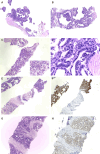Lessons learned from the first 2 years of experience with thyroid core needle biopsy at an Indonesian national referral hospital
- PMID: 40468609
- PMCID: PMC12138239
- DOI: 10.4132/jptm.2025.02.19
Lessons learned from the first 2 years of experience with thyroid core needle biopsy at an Indonesian national referral hospital
Abstract
Background: Core needle biopsy (CNB) improves diagnostic accuracy by providing precise tissue sampling for histopathological evaluation, overcoming the limitation of inconclusive fine-needle aspiration results. This study evaluated the diagnostic performance of CNB in assessing thyroid nodules, with additional analysis of the benefits of BRAF V600E and RAS Q61R immunohistochemical (IHC) markers.
Methods: This retrospective study enrolled patients with thyroid nodules who underwent CNB at Dr. Cipto Mangunkusumo Hospital, Jakarta, from July 2022 to July 2024. CNB diagnoses were classified using the Korean Thyroid Association Criteria. Diagnostic efficacy was evaluated for neoplastic and malignant lesions, both independently and with BRAF V600E and RAS Q61R IHC. The correlation between nodule size and postoperative diagnosis was also analyzed.
Results: A total of 338 thyroid nodule samples was included, and 52.7% were classified as CNB category II. In the 104 samples with postoperative diagnoses, category IV was the most prevalent (39.4%). CNB demonstrated a sensitivity of 74% and a specificity of 100% for neoplastic lesions and 23.8% sensitivity and 100% specificity for malignant lesions. Combining CNB with BRAF V600E and RAS Q1R IHC increased the sensitivity to 77% for neoplastic lesions and 28.8% for malignant lesions. Larger nodules (>3 cm) were significantly associated with neoplastic (p = .005) and malignant lesions (p = .004).
Conclusions: CNB performs well in identifying neoplastic lesions, with or without BRAF V600E and RAS Q61R IHC, but its low sensitivity for malignant lesions warrants caution. While CNB categories V-VI indicate malignancy, the possibility of malignancy in categories I-IV should not be overlooked.
Keywords: BRAF V600E mutation; Biopsy, large-core needle; RAS Q61R mutation; Thyroid cancer, papillary; Thyroid nodule.
Conflict of interest statement
The authors declare that they have no potential conflicts of interest.
Figures


Similar articles
-
Preoperative Risk Stratification of Follicular-patterned Thyroid Lesions on Core Needle Biopsy by Histologic Subtyping and RAS Variant-specific Immunohistochemistry.Endocr Pathol. 2023 Jun;34(2):247-256. doi: 10.1007/s12022-023-09763-3. Epub 2023 Apr 11. Endocr Pathol. 2023. PMID: 37040004
-
Initial clinical experience with BRAF(V600E) mutation analysis of core-needle biopsy specimens from thyroid nodules.Clin Endocrinol (Oxf). 2016 Apr;84(4):607-13. doi: 10.1111/cen.12866. Epub 2015 Aug 27. Clin Endocrinol (Oxf). 2016. PMID: 26215382
-
Evaluation of the Clinical Usefulness of BRAFV600E Mutation Analysis of Core-Needle Biopsy Specimens in Thyroid Nodules with Previous Atypia of Undetermined Significance or Follicular Lesions of Undetermined Significance Results.Thyroid. 2015 Aug;25(8):897-903. doi: 10.1089/thy.2014.0606. Epub 2015 Jul 8. Thyroid. 2015. PMID: 25978151
-
Diagnostic Performance of Core Needle Biopsy for Characterizing Thyroidectomy Bed Lesions.Korean J Radiol. 2022 Oct;23(10):1019-1027. doi: 10.3348/kjr.2021.0772. Epub 2022 Aug 31. Korean J Radiol. 2022. PMID: 36098339 Free PMC article. Review.
-
Comparison of core-needle biopsy and repeat fine-needle aspiration biopsy for thyroid nodules with initially inconclusive findings: a systematic review, diagnostic accuracy meta-analysis, and meta-regression.J Am Soc Cytopathol. 2025 May-Jun;14(3):159-169. doi: 10.1016/j.jasc.2024.12.006. Epub 2024 Dec 27. J Am Soc Cytopathol. 2025. PMID: 39843308
References
Grants and funding
LinkOut - more resources
Full Text Sources
Research Materials

